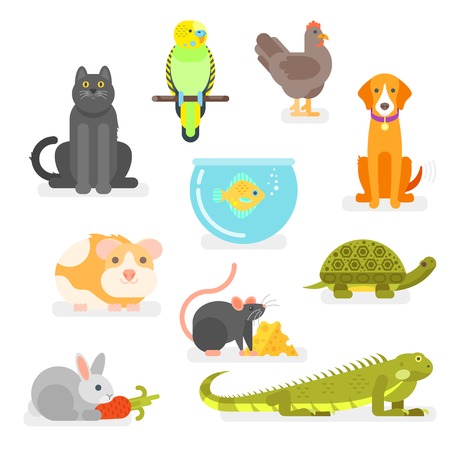Introduction to Pet Ownership and Insurance in the UK
Pet ownership holds a special place in British culture, with millions of households across the United Kingdom welcoming animals as valued family members. From loyal dogs and independent cats to rabbits, birds, and even exotic species, pets are considered an essential part of daily life for many Britons. The UK’s long-standing affection for animals is reflected not only in its popular literature and media but also in everyday routines, where walking the dog or caring for a cat is woven into the fabric of community living. This deep-rooted bond has fostered a strong sense of responsibility towards animal welfare and health.
As pets became increasingly integrated into homes and hearts, owners began to recognise the importance of safeguarding their companions against unexpected health issues or accidents. Veterinary care standards in the UK have steadily risen, bringing advanced treatments and longer lifespans for pets—but often at significant financial cost. It was this growing awareness of potential medical expenses that first sparked the idea of pet insurance solutions. Initially limited in scope, these early policies aimed to alleviate some of the anxiety associated with unforeseen veterinary bills, ensuring that financial concerns would not stand in the way of providing quality care for beloved animals.
2. Early Beginnings of Pet Insurance
The origins of pet insurance in the United Kingdom can be traced back to the late 20th century, a period marked by increasing awareness of animal welfare and a growing bond between people and their companion animals. The concept was inspired by the success of health insurance models for humans and livestock, which demonstrated the benefits of risk-sharing in managing unexpected veterinary costs. Pet insurance was first introduced as a niche product, aiming to support responsible pet ownership by providing financial protection against unforeseen illnesses and accidents.
Key Milestones in UK Pet Insurance History
| Year | Milestone | Description |
|---|---|---|
| 1947 | First Pet Insurance Policy | Bought by Swedish company Länsförsäkrings Alliance; set the groundwork for expansion into other countries, including the UK. |
| 1976 | Introduction to the UK Market | A British insurer launched the first official pet insurance policy, initially focusing on dogs and cats. |
| 1980s | Growth in Popularity | Pet insurance began gaining traction among UK households as veterinary care became more advanced—and expensive. |
| 1990s | Diversification of Policies | Insurers started offering tailored plans for different breeds and ages, as well as coverage for exotic pets. |
Notable Early Players and Influencers
Among the pioneering organisations was Petplan, established in 1976, which quickly became a household name and remains one of the most recognised pet insurers in Britain today. Veterinary professionals also played an influential role by educating pet owners about the benefits of insurance, further driving demand. Early adopters included animal charities such as The Kennel Club, which partnered with insurers to offer specialised policies for pedigree dogs.
Cultural Context: Why Did Pet Insurance Emerge?
The rise of pet insurance in the UK reflected broader societal changes. Pets were increasingly seen not just as animals but as valued members of the family. This shift led to higher expectations for veterinary care, with owners seeking advanced treatments that could come at considerable cost. Insurance provided peace of mind, allowing Britons to safeguard their pets’ health without facing financial hardship—a principle that resonated strongly with the nation’s ethos of compassion and responsibility towards animals.

3. Growth and Mainstream Adoption
The expansion of pet insurance in the United Kingdom was shaped by several key factors that contributed to its widespread acceptance among pet owners. One significant driver was the steady rise in veterinary costs over recent decades. As advances in veterinary medicine made more sophisticated treatments available, the expense of caring for pets increased considerably. This shift meant that many pet owners faced unexpected bills for surgeries, diagnostics, and ongoing management of chronic conditions—costs that could quickly add up and become unmanageable without some form of financial support.
Alongside this, there was a growing awareness of pet health and wellbeing across British society. Pets became more than just companions; they were increasingly viewed as members of the family, deserving of comprehensive healthcare. Public campaigns and educational initiatives by animal welfare organisations highlighted the importance of regular check-ups, preventive care, and prompt treatment, further encouraging responsible ownership. These cultural changes led to heightened expectations regarding the standard of care provided to pets.
Insurance providers responded to these trends by offering a wider array of policy options tailored to different needs and budgets. Flexible coverage plans, including accident-only policies, time-limited cover, and lifetime insurance, enabled more pet owners to find suitable protection for their animals. The introduction of online comparison tools also made it easier for consumers to research and select policies that matched their requirements.
The increasing prevalence of pedigree pets—often with specific health risks—further fuelled demand for insurance products. As owners sought reassurance against potential hereditary or breed-related conditions, insurers adapted by offering specialised cover and advice.
Ultimately, the convergence of rising veterinary fees, enhanced understanding of animal health, and evolving social attitudes towards pets created fertile ground for pet insurance to become a mainstream component of responsible pet ownership in the UK.
4. Evolving Coverage Options
Over the years, pet insurance in the United Kingdom has undergone significant transformation, both in terms of what is covered and the types of pets that can be insured. In the early days, policies were relatively basic, mainly focusing on dogs and cats, and offering limited reimbursement for veterinary treatments following accidents or illnesses. However, as the needs of pet owners evolved and veterinary medicine advanced, insurers began to expand their product offerings.
Today’s pet insurance products are far more comprehensive, catering to a diverse range of animals including rabbits, exotic birds, reptiles, and even small mammals. Insurers have responded to consumer demand for broader protection by introducing new policy features that address an extensive array of medical conditions—from chronic illnesses like diabetes and arthritis to hereditary diseases and behavioural therapy.
Key Developments in Pet Insurance Coverage
| Coverage Feature | Early Products | Modern Products |
|---|---|---|
| Species Covered | Mainly dogs and cats | Dogs, cats, rabbits, birds, reptiles, small mammals |
| Medical Conditions | Accidents and basic illnesses | Chronic conditions, hereditary diseases, dental care, behavioural issues |
| Preventative Care | Rarely included | Vaccinations, flea/tick treatments, annual health checks |
| Wellness Benefits | Not available | Nutritional advice, routine screening tests, alternative therapies |
The Rise of Wellness and Preventative Care Plans
A notable shift in recent years has been the introduction of wellness and preventative care options within pet insurance policies. Recognising the importance of proactive health management—both for improving animal welfare and reducing long-term veterinary costs—insurers now offer cover for routine check-ups, vaccinations, parasite control, dental cleaning, and even complementary therapies such as physiotherapy and hydrotherapy.
A Holistic Approach to Pet Health
This evolution reflects a broader trend towards holistic pet care in the UK. Modern pet owners are increasingly aware that prevention is better than cure—a philosophy echoed by many British veterinarians. By incorporating wellness benefits into their policies, insurers not only support responsible pet ownership but also help reduce the incidence of preventable illnesses and promote longer, healthier lives for pets across the country.
5. Current Landscape and Market Trends
The UK pet insurance market has matured into one of the most robust sectors in Europe, reflecting both the nation’s deep affection for animals and a strong focus on preventative health care. At present, industry leaders such as Petplan, Animal Friends, and Bought By Many (now known as ManyPets) dominate the market, offering a diverse range of policies tailored to dogs, cats, and increasingly, exotic pets. According to recent statistics, over 3.4 million pets are insured in the UK, with approximately 30% of dog owners and 16% of cat owners opting for insurance cover. This high uptake is driven by rising veterinary costs and greater public awareness of the benefits of comprehensive pet insurance.
Policyholder Preferences and Coverage Options
Todays policyholders are seeking flexibility and transparency in their coverage. Lifetime policies remain the most popular choice, ensuring ongoing protection against chronic illnesses. There is also a growing demand for wellness add-ons that cover routine check-ups, vaccinations, dental care, and even behavioural therapies. As more Britons view their pets as family members, insurers are adapting products to include holistic health support alongside traditional accident and illness cover.
Emerging Digital Trends
The digital transformation has significantly impacted the pet insurance sector. Online platforms now enable instant quotes, simplified claims processing, and personalised policy management. The use of mobile apps and telemedicine services is on the rise, providing policyholders with convenient access to veterinary advice and claim submissions from the comfort of their homes. Data-driven underwriting is also helping insurers offer more competitive premiums based on breed-specific risk factors.
Sustainability and Ethical Considerations
With increasing consumer focus on sustainability and animal welfare, several insurers have introduced eco-friendly initiatives—such as paperless documentation and partnerships with animal charities. These efforts align closely with British values around responsible pet ownership and environmental stewardship.
In summary, the current landscape of UK pet insurance is defined by innovation, customer-centricity, and an evolving understanding of pet wellbeing. With continued advances in digital technology and preventive healthcare options, the sector is well-positioned to meet the changing needs of Britain’s devoted pet owners.
6. Future Prospects and Challenges
Looking ahead, the future of pet insurance in the United Kingdom is shaped by both exciting opportunities and significant challenges. The industry is expected to continue its steady growth as more households recognise the importance of safeguarding their pets’ health and wellbeing. However, affordability remains a central concern. With rising veterinary costs and increased demand for comprehensive coverage, insurers must find innovative ways to offer accessible policies without compromising quality. The integration of technology stands out as a major driver for transformation in the sector. Advancements such as tele-veterinary consultations, digital claims processing, and personalised risk assessments powered by artificial intelligence are poised to streamline services and enhance customer experience.
Affordability and Access
One of the most pressing issues is ensuring that pet insurance remains within reach for all pet owners, regardless of their financial circumstances. Insurers may need to develop flexible policy options, such as modular coverage or tiered plans, which cater to varying needs and budgets. Additionally, regulatory support could help keep premiums fair while encouraging transparency in policy terms.
Technology Integration
The ongoing digital transformation presents vast potential for improving efficiency and reducing administrative burdens. Mobile apps for managing policies, instant claim submissions, and real-time health monitoring through wearable devices can empower pet owners with actionable insights. These technological advancements not only benefit consumers but also enable insurers to better assess risks and tailor products to individual pets’ needs.
Consumer Awareness and Education
Despite growing popularity, there remains a knowledge gap among many UK pet owners about the benefits of insurance and how it works. Industry stakeholders will need to invest in educational campaigns that demystify policy details, promote preventive care, and highlight the long-term savings associated with being insured. Enhanced collaboration with veterinary professionals could also foster greater trust and uptake among consumers.
In conclusion, while the evolution of pet insurance in the UK has been remarkable, its future depends on addressing key challenges surrounding affordability, embracing technological innovation, and increasing consumer understanding. By focusing on these areas, the industry can ensure it remains relevant and supportive of Britain’s cherished pets for generations to come.


